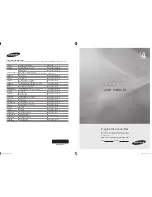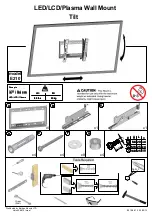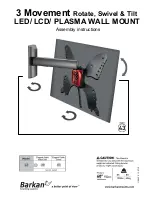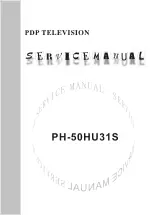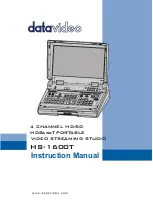
Service Modes, Error Codes, and Fault Finding
5.
Figure 5-1 ComPair interface connection
The set has now started up in ComPair mode. Follow the
instructions in the faultfinding tree to diagnose the set. Note
that the OSD works, but the actual user control is disabled
5.5
Error Buffer
5.5.1
Introduction
The error code buffer contains all detected errors since the last
time the buffer was erased. The buffer is written from left to
right. When an error occurs that is not yet in the error code
buffer, it is written at the left side and all other errors shift one
position to the right.
5.5.2
How to Read the Error Buffer
Use one of the following methods:
•
On screen via the SAM (only if you have a picture).
Examples:
–
ERROR: 0 0 0 0 0 :
No errors detected
–
ERROR: 6 0 0 0 0 :
Error code 6 is the last and only
detected error
–
ERROR: 9 6 0 0 0 :
Error code 6 was detected first and
error code 9 is the last detected (newest) error
•
Via the blinking LED procedure (when you have no
picture). See 'The Blinking LED Procedure' section.
•
Via ComPair.
5.5.3
How to Clear the Error Buffer
Use one of the following methods to clear the error buffer:
•
Activate the 'CLEAR ERRORS' command in the SAM
menu.
•
Transmit the command 'DIAGNOSE-99-OK' with ComPair.
•
If the contents of the error buffer have not changed for 50
hours, the error buffer resets automatically.
5.5.4
Error Codes
If the set has non-intermittent faults, clear the error buffer
before starting repairs. This is to ensure that “old” error codes
are not present.
If possible, check the entire contents of the error buffer. In
some situations, an error code is only the result of another error
code (and not the actual cause of the problem). For example,
a fault in the protection detection circuitry can also lead to a
protection.
Table 5-1 Error Codes
Explanation of error codes:
Error 0
No errors
Error 1
‘FBX 3V3 protection’
This protection is activated when the PICNIC (pos. 7709 on
diagram B3) cannot communicate via I
2
C for a certain time.
This could mean that stabilizer 7009 (B7) or 7713 (B3) on SSB
(depending on the set) is defective. When there is a short circuit
to ground behind the stabilizer, 7009 or 7713 could become
very hot. For safety reasons, the set will switch to protection
mode.
Error 2
‘No Horizontal Flyback protection’
The HOP (pos. 7301 on diagram B4 detects the absence of an
HFB pulse (pin 3 of connector 1424 on LSP, diagram A3)). A
bit will be set in the HOP. After filtering by the software, the set
will switch to protection mode.
Error 4
‘+5V protection’
When the +5V protection is active, the set is switched to
protection mode and error code 4 is placed in the error buffer.
The LED will blink 4 times (repeatedly).
A 5V failure can cause a drop in the 5V supply output, resulting
in an undefined behavior of the set. Therefore, some I
2
C
devices (Tuner and MSP) connected to the 5V supply are
constantly monitored. When none of these devices responds to
the microprocessor for a prolonged time, the microprocessor
assumes that there is a failure in the 5V supply.
By starting up (by disconnecting/reconnecting the set from the
mains) the set while short-circuiting the SDM solder pads on
the SSB, the +5V protection will be overridden, and it will be
easier to determine the cause. The +5V protection will be
activated when these I
2
C devices fail (no I
2
C communication):
–
Main Tuner (pos. 1200 on the LSP),
–
MSP3452 sound processor (pos. 7651 on the SSB).
CL96532159_029.eps
190601
PC
VCR
I2C
Power
9V DC
R
L
AUDIO
EXTERNAL 1
EXTERNAL 2
SERVICE
CONNECTOR
Error Device
Description
Remarks
1
FBX 3V3 protec-
tion
FBX 3V3 protection -
2
No HFB
No Horizontal Fly-
back
-
4
5V protection
5V protection
-
5
No HOP POR
Startup failure
-
6
General I2C bus
error
General I2C bus er-
ror
-
7
Mains Dip error
HW error
-
9
TEDE9
Tuner protection
-
10
MC24C32
NVM communica-
tion error
-
11
MC24C32
NVM identification
error
-
12
SAA5667
Main uP, int. RAM
test failure
-
14
MSP3451
MSP34xx
-
15
CY7C1019
SRAM test failure
EM1.1A only
22
TDA9178
Histogram IC
-
30
TDA9320
HIP I/O video
processing
-
31
SAA4978
PICNIC
-
32
TDA9330
HOP video control/
geometry
-
35
M62320
I/O expander HD
Jack
-
Summary of Contents for EM1.1A
Page 35: ...Circuit Diagrams and PWB Layouts 35 EM1 1A AA 7 Layout LSP Top Side ...
Page 37: ...Circuit Diagrams and PWB Layouts 37 EM1 1A AA 7 Layout LSP Overview Bottom Side ...
Page 38: ...38 EM1 1A AA 7 Circuit Diagrams and PWB Layouts Layout LSP Part 1 Bottom Side ...
Page 39: ...Circuit Diagrams and PWB Layouts 39 EM1 1A AA 7 Layout LSP Part 2 Bottom Side ...
Page 40: ...40 EM1 1A AA 7 Circuit Diagrams and PWB Layouts Layout LSP Part 3 Bottom Side ...
Page 41: ...Circuit Diagrams and PWB Layouts 41 EM1 1A AA 7 Layout LSP Part 4 Bottom Side ...
Page 116: ...116 EM1 1A AA 7 Circuit Diagrams and PWB Layouts Personal Notes E_06532_013 eps 131004 ...




































